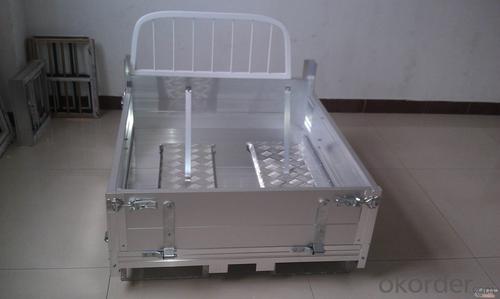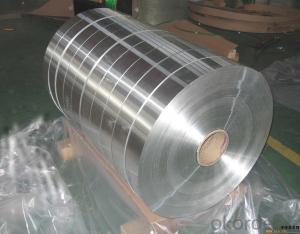3mm Thick Honeycomb Aluminum Sheets for Manufacturing Truck Body
- Loading Port:
- Shanghai
- Payment Terms:
- TT OR LC
- Min Order Qty:
- 5 m.t.
- Supply Capability:
- 9000 m.t./month
OKorder Service Pledge
OKorder Financial Service
You Might Also Like
Specification
1 Specifications of Aluminum sheets for Truck Body
Main Specification | |
Alloy | AA3xxx (AA3003, AA3004, AA3005, AA3105 etc. |
AA5xxx (AA5052, AA5754, AA5083 etc. | |
AA6xxx (AA6061, AA6063 etc. | |
Temper | H14, H16, H18, H22, H24, H26, H32, O/F, T3-T6 |
Thickness | 0.2mm-100mm |
Width | 30mm-1700mm |
Standard | GB/T 3880-2006 |
Special specification is available on customer’s requirement | |

2 Size Tolerance (mm)
Size | Tolerance |
≤1 | 0.10 |
>1-2 | 0.12 |
>2.3 | 0.14 |
>3-4 | 0.16 |
>4-6 | 0.18 |
>6-12 | 0.20 |
>12-19 | 0.23 |
>19-25 | 0.25 |
>25-38 | 0.30 |
>38-50 | 0.36 |
>50-100 | 0.61 |
>100-150 | 0.86 |
>150-200 | 1.12 |
>200-250 | 1.37 |
3 Usage/Applications of Aluminum sheets for Truck Body
Our company's PE Coated Aluminum Coil/Sheet have been widely used in the fields of construction and decoration(garage doors, ceiling etc.), electronic appliances, lighting decoration, air-condition air pipe, sanwich panels and drainage, etc.

4 Packaging & Delivery & Payment term of Aluminum sheets for Truck Body
Packaging: Seaworthy package, plastic bag covered inside, carton wrapped outside, paper core, on the wooden pallet. Pallet weight: 1000-25000KG.
Shipment: the goods will be delivered within 40 days after getting the buyer's payment.
Terms of payment: T/T or L/C.
5 Basic Production Process
Aluminium bar cutting → Aluminium bar heat treatment → Aluminium ingot → Hot extruding → Straightening → Heat treatment → Profiles cutting →Packing → Delivery

- Q: How do aluminum sheets perform in terms of fire resistance?
- Aluminum sheets have excellent fire resistance properties. Aluminum is a non-combustible material, meaning it does not burn or contribute to the spread of fire. In fact, aluminum has a high melting point of around 660 degrees Celsius (1220 degrees Fahrenheit), which makes it highly resistant to heat. When exposed to fire, aluminum forms a thin layer of oxide on its surface, which acts as a protective barrier against further oxidation. This oxide layer is highly stable and helps to prevent the material from igniting or releasing flammable gases. Additionally, aluminum sheets have low thermal conductivity, which means they do not transfer heat as easily as other metals, further enhancing their fire resistance. These fire-resistant properties make aluminum sheets a preferred choice in various applications where fire safety is a concern, such as building construction, aerospace industry, automotive manufacturing, and electrical enclosures. Aluminum sheets are often used in exterior cladding, roofing, and insulation systems, where they provide an additional layer of protection against fire hazards. It is important to note that while aluminum sheets themselves are highly fire-resistant, the overall fire performance of a structure or system depends on the design, installation, and other materials used in combination with aluminum sheets. Therefore, it is crucial to follow appropriate fire safety regulations and guidelines to ensure optimal fire resistance in any given application.
- Q: How does aluminum sheet perform in high-pressure applications?
- Aluminum sheet performs exceptionally well in high-pressure applications due to its inherent properties. The strength-to-weight ratio of aluminum is impressive, making it a suitable choice for withstanding high-pressure environments. Additionally, aluminum has excellent corrosion resistance, which is crucial when dealing with high-pressure conditions that may involve exposure to moisture or aggressive chemicals. Furthermore, aluminum sheet is highly malleable, allowing it to be fabricated into various shapes and forms to meet the specific requirements of high-pressure applications. Its flexibility also enables it to withstand the forces and stresses exerted during high-pressure processes without compromising its structural integrity. Moreover, aluminum has good thermal conductivity, which aids in dissipating heat generated by high-pressure systems. This feature helps prevent overheating and ensures efficient operation. However, it is important to note that the performance of aluminum sheet in high-pressure applications can be influenced by factors such as the thickness and alloy composition of the sheet. Therefore, it is crucial to select the appropriate grade and thickness of aluminum sheet based on the specific requirements and operating conditions of the high-pressure application. Overall, aluminum sheet is a reliable and effective choice for high-pressure applications due to its strength, corrosion resistance, malleability, thermal conductivity, and overall performance under demanding conditions.
- Q: This question asks for methods to protect aluminum sheets from damage during transportation and storage.
- <p>To prevent damage to aluminum sheets during transportation or storage, follow these guidelines: 1) Use protective packaging such as bubble wrap or padded covers to prevent scratches and dents. 2) Store aluminum sheets in a dry, cool place away from moisture and direct sunlight to avoid corrosion. 3) Stack sheets with soft padding between them to prevent surface damage. 4) Securely strap or brace the sheets during transport to prevent movement and potential damage. 5) Handle aluminum sheets with clean, dry hands or use gloves to avoid leaving fingerprints or oils that can cause corrosion. 6) Ensure that transportation vehicles are clean and dry to prevent any contaminants from coming into contact with the aluminum. By adhering to these practices, you can minimize the risk of damage to aluminum sheets.</p>
- Q: just bought a hobart handler 140 (already love it), and was just wondering on what gas to use for aluminum. my welder will be set up for mild steel (75% argon 25% CO2). it would be nice to be able to use this mix with aluminum as well, as it would be easy to just switch spools of wire, but the manual says to use a 100% argon mix when welding with aluminum. will the 25% CO2 make a difference welding aluminum?
- Get the kit which will have new drive wheels and the liner, and get the right gas, and don't plan on using any thin aluminum, I was never able to have fine enough control on my machine to get it to work well on anything less than 1/8 material. Also, you will probably buildup too much heat and burn through if you try to go far, weld about 1 at a time and let the material cool. Your machine and mine are just barely on the edge of being capable of doing this. It is nearly impossible to dial it in to a reliable point.
- Q: Are aluminum sheets suitable for signage?
- Yes, aluminum sheets are suitable for signage. They are lightweight, durable, and weather-resistant, making them a popular choice for outdoor and indoor signage applications. Additionally, aluminum sheets can be easily customized, printed, and mounted, allowing for versatile and long-lasting signage solutions.
- Q: Can aluminum sheets be used for roofing?
- Yes, aluminum sheets can be used for roofing. Aluminum is a popular choice for roofing materials due to its durability, lightweight nature, and resistance to corrosion. Aluminum roofing sheets are known for their longevity, as they can last for several decades without the need for replacement. Additionally, aluminum has excellent reflective properties, which can help to reduce energy costs by keeping the building cooler in hot climates. Moreover, aluminum is easy to install, making it an attractive option for roofing projects. Overall, aluminum sheets are a reliable and practical choice for roofing applications.
- Q: Not just cans. How is aluminum recycled and what is the process. Not the scientific formula! How its done entering the plant.
- Aluminum okorder
- Q: I recently moved into a 1975 house with aluminum wiring. I will be going through and checking/replacing all receptacles and switches with CO/ALR rated ones as I don't have a budget right now to rewire the house. I am wondering if I should be checking all of the ceiling lights as well as some of them would be very difficult to access. Are lights as big a concern with aluminum connections as receptacles? I am sure some of the lights are newer and would have copper wire connected to the aluminum. Should I be concerned about the type of wire nuts used here?Anything else that I should be checking?
- Connections at ceiling lights have far less potential for a problem, but a potential none the less. So, while you are at it, go ahead and check them. The antioxidant compound and al/cu listed wire nuts (marriets) are the correct and proper materials to use. I applaud you for having done your homework. After tightening each connector be sure to pull on each and every wire to ensure they are good and tight. When combining solid and stranded wire, slide the stranded past the solid about an 1/8 before capping. We in the trade use 9 lineman's pliers to twist all wires before capping them. An inexpensive pair (of Lineman's) can be had for under $20. A good pair of wire strippers (with built in screw cutters) can be had for about $15. I mention the screw cutter because there is a good chance that somewhere along the line you will find a location where the stock 7/8-1 screw bottoms out against something before it gets tight. If you force it it will strip out. Not to mention it might dig into the insulation on a wire resulting in a short. Screws in devices (receptacles, switches, dimmers etc.) are 6-32 and light fixtures are typically 8-32. I would also get a non-contact tester. A.k.a. inductive tester. Very handy at times. When you are sure the power is off to a box it might not be. On an occasion another hot will be present. The beep testers will quickly alert you to the presence of another live circuit. A multi-tester will allow you to identify wires should you fail to mark them before working on them. If you mark the location of each wire to a 3 or 4-way switch before replacing it you will save yourself a lot of time. Same with wires to any GFI receptacles. Swapping wires location to location may not be correct. Some have the Line terminals on one side, while most have them on the top. But I get the impression you have a bit of experience or a friend who does helping you with this.
- Q: Can aluminum sheets be welded or joined together?
- Indeed, welding or joining together aluminum sheets is possible. Aluminum possesses excellent weldability, allowing for its fusion through diverse welding techniques such as gas tungsten arc welding (GTAW), gas metal arc welding (GMAW), and laser welding. These methods involve the application of heat to liquefy the aluminum sheets and establish a robust connection. Furthermore, mechanical fasteners like screws, rivets, or adhesive bonding can also be employed to join aluminum sheets. The selection of the welding or joining approach hinges upon the particular application and the desired result.
- Q: How does aluminum sheet perform in extreme temperatures?
- Aluminum sheet performs well in extreme temperatures as it has a high melting point of 660°C (1220°F) and exhibits excellent thermal conductivity. It can withstand both hot and cold temperatures without significant deformation or structural damage, making it suitable for various applications in extreme environments.
Send your message to us
3mm Thick Honeycomb Aluminum Sheets for Manufacturing Truck Body
- Loading Port:
- Shanghai
- Payment Terms:
- TT OR LC
- Min Order Qty:
- 5 m.t.
- Supply Capability:
- 9000 m.t./month
OKorder Service Pledge
OKorder Financial Service
Similar products
Hot products
Hot Searches
Related keywords




























